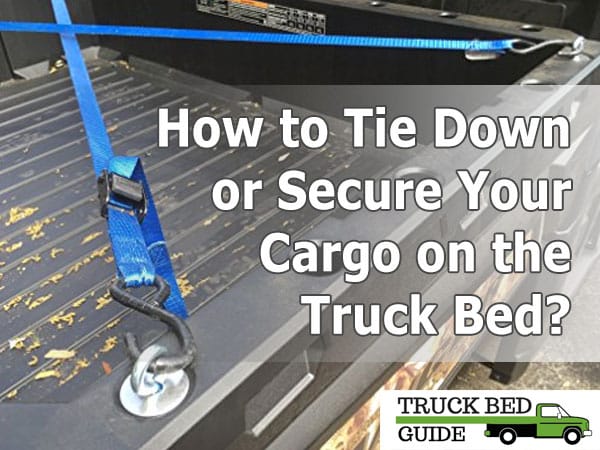When you are carrying your cargo on a long trip, you have to make sure that they are secure at their place; moreover, they remain secure and tight at all condition even if you face a rough patch or the weather decides to challenge you. Carrying large cargo is no big deal you have to make sure they stay put.
Securing or tieing down your cargo to the truck bed may seem a menial work but the truth is it is the most important aspect of hauling cargo and requires much of your time, effort and expertise.
According to AAA’s Foundation for Traffic Safety, unsecured cargo caused more than 200,000 crashes with 500 deaths in the USA in the last four years. The crashes could have been prevented if the loads were secured properly. So, now you know, that securing cargo in the truck bed is not to be taken casually!
We have found that many truck owners are confused about how to secure their cargo and are not aware of their options. So, after doing some research and talking to fellow truck owners we have come up with the solution to give you peace of mind when you are on the road, knowing that your cargo is secure.
Table of Contents
5 Steps to Properly Transport your Cargo
1. Get the Right Equipment
First, you have to know what equipment you need to secure your cargo in your truck bed. You will need to invest in some quality equipment such as anchor points and ratchet straps. Even without the anchor points, you can manage to tie your cargo but it may come off when you hit an uneven road.
So, tie-down straps and anchor points are absolutely essential to restraint your cargo and they come with a rated capacity so you know how much weight you can haul. So, purchase tie-down points and straps depending on the cargo you will be carrying.
Some trucks do come with built-in anchors, but they are often stuck to the bottom of the bed, which is not exactly convenient when you have a lot to carry. We suggest you mount anchor points in the rail stake pockets. This will give a secure tie-down even for taller loads.
2. Note Your Truck’s Load Capacity
Don’t forget your truck’s load capacity while loading your cargo. Check your owner’s manual for the truck’s gross vehicle weight rating (GVWR). You may even find on the rim of the driver’s door. It is not wise to exceed the truck’s load capacity, otherwise, it will damage your truck and could pose a threat to other drivers on the road.
3. Keep Heavier Loads Near the Cab
Make sure you keep all your heavier items towards the cab end of the truck bed. This will prevent your truck from getting too much pressure at the back which will cause poor steering and handling. The cab end of the bed is also the center of the whole truck, relatively! So, it results for a better weight distribution and stability. This will also help you save some gas.
4. Tie Down the Load on Both Sides
After you have decided how you are going to lay down your cargo, you will need to decide on securing it to the bed. Run two ratchet strap on the bed floor one near the tailgate and the other on the cab end. Lay your cargo on top of the ratchet straps. Make loops around the cargo and strap it to the anchor points.
Make sure, it is tight and not flexible. After securing the cargo on both sides, you also have to secure it from to back. Use a few more ratchet straps and fasten it to the anchor points. Even if you drive with your tailgate on, the straps will prevent your load from sliding around.
5. Attach a Red Flag to Long Loads
If you are carrying long loads such as lumber of piping, you are required by law to attach a red flag to the end of the overhang. If necessary, use a reflector and temporary red lights if you will be driving at night.
Top Mistakes to Avoid When Tying Down Cargo on Your Pickup Truck
While securing their cargo, many truck owners overlook a few necessary things which otherwise should be given much attention and effort.
1. Lack of Planning and Preparation
Transporting cargo does take some planning. A little preparation and forethought will prevent you from damaging your cargo and even prevent road accidents. Make sure you have the right items beforehand such as straps, ropes, nets, tarps, etc. Prep your truck bed floor by hosing it out for any remaining debris.
Drop-on a rubber mat to protect your truck bed as well as prevent cargo from sliding out. Carry a toolbox along with extra tools and straps.
2. Using the Wrong Equipment
Cargo net and tarp are a good option for lighter loads. It will prevent your smaller items and lighter loads from flying around but that’s not a good solution for larger and heavier cargo. If you are going to use only a net or a tarp for the whole load, make sure you get the right size and check if it can really hold-on.
Furthermore, avoid using old ropes to tie down your cargo. We suggest you get new ratchet straps, ropes or bungee cords if needed.
3. Poorly Tied Cargo
Truck owners often overlook using high-quality equipment for securing cargo. They often tend to use old ropes and other tool laying around their garage to make do with the tying process. This is not only wrong but also dangerous. You have to use proper straps and tie them down from all sides. Install tie-down points if necessary.
Many truck owners tend to strap the whole of cargo on one side of the truck leaving the other side empty. This may cause your cargo to slide and move around while you drive. Make sure the weight is distributed evenly on the bed and the cargo is fastened from both sides as well as front to back.
4. Overlooking The Load Capacity
Make sure to check the load capacity of your truck bed as well as the tie-down anchor points. If you are using tarps and net, make sure they can withstand the amount of load you will be carrying.
Equipment You Need to Tie Down Loads on Your Truck Bed
1. Ropes
Ropes are a great option to secure your load. However, make sure it’s strong enough to hold your load weight. A good option would be a nylon rope, which is effective in making secure knots. Fiber ropes, on the other hand, come off easily. Plastic ropes are also a good option but it’s a struggle to make a tight knot with it.
Although ropes are an inexpensive way to secure your cargo, it still has some downsides. First, it is difficult to tie it tightly, which usually tends to loosen up. Even if you manage to give it a tight knot it may become difficult to untie it especially when it’s wet in the rain.
For large cargo, you will need multiple ropes which when tied down makes a big mess, creates a big knotted pile and doesn’t even cover all area. Small items can easily slip out. Ropes are also not the best option for uneven cargo.
2. Ratchet Strap
Ratchet straps are more secure options for securing your load. They are available in a variety of sizes, lengths and varying load capacity. Its simple and secure locking mechanism makes it easier for a truck owner to secure their loads.
It comes with hooks on both ends, which means, it doesn’t have to be tied down. Most importantly, it stays tight during transit.
It has some downsides too, such as over tightening may damage your cargo. Sometimes the strap jams in the ratchet. Much like ropes, it too may create a messy setup.
3. Cargo Cover
Cargo cover or tarps are useful only in a few situations and are not the best solution to secure your cargo. They are available in various sizes to fit your needs and are made from sturdy material. If it’s a rainy day, the tarps will keep your cargo dry. It is also useful when you are carrying loose items which may fly out of the truck bed.
On the other hand, it has a lot of downsides such as they rip easily under pressure. They are difficult to tie to prevent flapping and tearing. Wet tarps have to be dried out before storing. And, it generally can’t handle irregular loads.
4. Bungee Cords
These rubber straps come in handy to secure cargo and prevent objects from shifting or sliding. But bungee cords alone is not a wise solution to secure your cargo. It should be used as an accessory to help tie down other equipment such as tarps, cargo net etc. The cords have hooks on both ends which makes it easier to stretch over uneven objects and secure it from both sides. Here you can buy a decent number of bungee cords at a great price.
5. Elastic Cargo Net
An elastic cargo net is often used along with cargo cover. It fits the whole of cargo snugly, depending on the size of the cargo net. When used with a cargo cover, it will keep the tarp in place as well as protect your cargo from the rain. However, the cargo net is not sturdy enough to withstand heavy loads. Here is a good option for an elastic cargo net.
It is better used to keep small tools and items in place but can’t prevent big loads from moving around. However, along with ratchet straps or ropes, it can provide additional security.
How to Tie an Invincible Knot?
To tie a knot is an art in itself and in fact, there are various kinds of knots and hitches such as bowline hitch, tautline hitch and many more. But, when you are carrying cargo on your truck bed you should learn to tie a trucker’s hitch knot.
The trucker’s hitch knot gives a tight cinch down the load. It enables the line to be pulled tightly and keep things secure. It is typically used by truckers to secure heavy loads and works well on your truck bed when you are carrying your cargo.
Steps to Tie a Trucker’s Hitch Knot
- Tie one end of the rope to an anchor or a fixed object. Create a slippery half hitch to form a loop in the middle of the rope.
- Make the open end wrap around another anchor point and run the free end through the loop.
- Use this loop as a pulley to tighten the rope around the load. Then secure the know with two half hitches around one line.
Conclusion
Securing and tying down your cargo on the truck bed is not an easy job. It takes some planning and effort. Plus with experience, you will get the hang of it. If it’s a snowy or a rainy day, you have to make proper arrangement to keep your cargo dry.
Plus if your cargo overhangs and you will be driving at night, make sure you have proper lighting to intimate your fellow drivers. Most importantly, when you are hauling cargo always make sure you are within the boundaries of your state’s transportation laws.

With a wrench in one hand and a trucker’s hat on my head, I’ve been knee-deep in the world of trucks for over a decade. From tinkering in greasy garages to cruising down open highways, my life has been one big trucking adventure. I’ve hauled, repaired, and revved up more rigs than I can count, and now I’m revving up your truck knowledge with articles that’ll steer you right.








